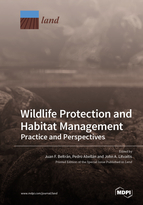Wildlife Protection and Habitat Management: Practice and Perspectives
A special issue of Land (ISSN 2073-445X).
Deadline for manuscript submissions: closed (28 February 2022) | Viewed by 51576
Special Issue Editors
Interests: conservation biology; evolutionary biology; animal ecology; wildlife management; herpetology; mammalogy
Interests: origin, distribution and conservation of biodiversity
Special Issue Information
Dear Colleagues,
We invite you to send your contributions to this Special Issue of Land focusing on “Wildlife Protection and Habitat Management: Practice and Perspectives”. The aim of this issue is not just revisiting classic topics in the area (such as keystone species, habitat fragmentation, PVAs, etc.), but to critically review what has been successfully done (at different levels: species, habitats, legislation, interactions between academic and management institutions, etc.) and the critical issues that require the allocation of both human effort (research, monitoring, legislation, human dimensions, etc.) and economic resources (e.g., LIFE programs, protected areas national programs) to tackle new or increasing biodiversity threats (such as habitat destruction, invasive species, climate change, illegal trade, wildlife–human conflicts, animal-borne diseases, etc.).
Wildlife and habitat management is an interdisciplinary field that encompasses many scientific disciplines and impacts the lives of people. It is, therefore, a truly applied science, where human dimensions play an important role. Submissions should consider these two driving ideas: a) the importance of conducting good scientific studies (i.e., accessing reliable scientific information) to design and implement effective wildlife and habitat management, and b) that achieving the goal of sustainable development needs the contribution and expertise of wildlife and habitat management specialists. As impacts increase, science and specialists are demanding more support and resources. This Special Issue is an opportunity to extract and disseminate experience from previous and ongoing studies worldwide. It will offer a good picture of current developments in the field.
Thanks again for your consideration to contribute to this Special Issue.
Prof. Dr. Juan F. Beltrán
Dr. Pedro Abellán
Prof. Dr. John Litvaitis
Guest Editors
Manuscript Submission Information
Manuscripts should be submitted online at www.mdpi.com by registering and logging in to this website. Once you are registered, click here to go to the submission form. Manuscripts can be submitted until the deadline. All submissions that pass pre-check are peer-reviewed. Accepted papers will be published continuously in the journal (as soon as accepted) and will be listed together on the special issue website. Research articles, review articles as well as short communications are invited. For planned papers, a title and short abstract (about 100 words) can be sent to the Editorial Office for announcement on this website.
Submitted manuscripts should not have been published previously, nor be under consideration for publication elsewhere (except conference proceedings papers). All manuscripts are thoroughly refereed through a single-blind peer-review process. A guide for authors and other relevant information for submission of manuscripts is available on the Instructions for Authors page. Land is an international peer-reviewed open access monthly journal published by MDPI.
Please visit the Instructions for Authors page before submitting a manuscript. The Article Processing Charge (APC) for publication in this open access journal is 2600 CHF (Swiss Francs). Submitted papers should be well formatted and use good English. Authors may use MDPI's English editing service prior to publication or during author revisions.
Keywords
- animal diseases
- biodiversity
- conservation biology
- connectivity
- endangered species
- habitat fragmentation
- human dimensions
- invertebrates
- IUCN
- management
- monitoring
- sustainable development
- stakeholders
- vertebrates
- wildlife








